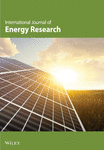Measurements and numerical simulations for optimization of the combustion process in a utility boiler
Abstract
A three-dimensional computational fluid dynamics code was used to analyse the performance of 550MW pulverized coal combustion opposite a wall-fired boiler (of IEC) at different operation modes. The main objective of this study was to prove that connecting plant measurements with three-dimensional furnace modelling is a cost-effective method for design, optimization and problem solving in power plant operation. Heat flux results from calculations were compared with measurements in the boiler and showed good agreement. Consequently, the code was used to study hydrodynamic aspects of air–flue gases mixing in the upper part of the boiler. It was demonstrated that effective mixing between flue gases and overfire air is of essential importance for CO reburning. From our complementary experimental-numerical effort, IEC considers a possibility to improve the boiler performance by replacing the existing OFA nozzles by those with higher penetration depth of the air jets, with the aim to ensure proper mixing to achieve better CO reburning. Copyright © 2004 John Wiley & Sons, Ltd.




